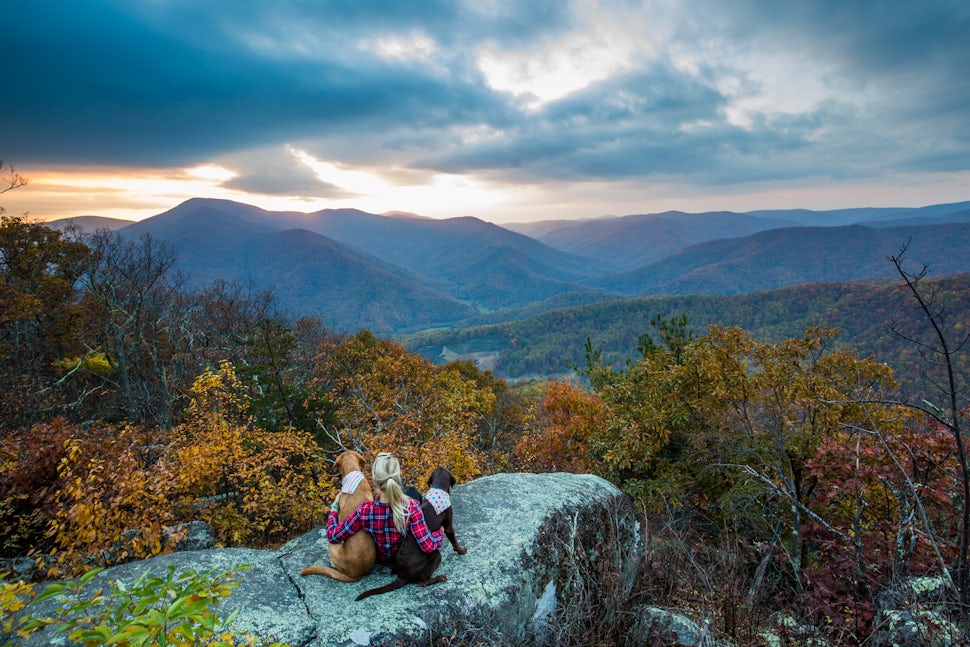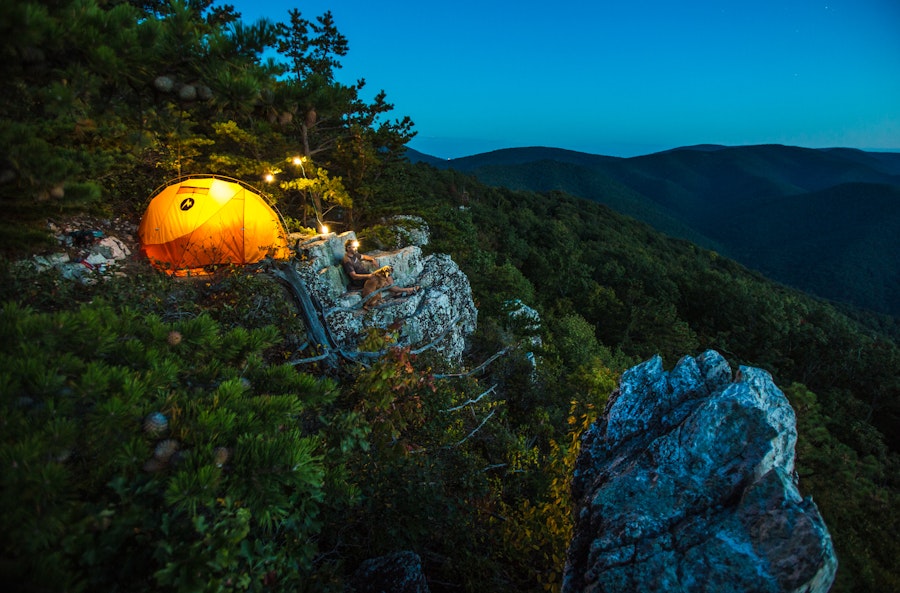10 Tips For Backpacking With Your Dog
Backpacking with your faithful canine companion can be an awesome experience.

I began taking my two dogs on hiking and backpacking trips with me when I moved out to Spokane, WA a little over a year ago. Prior to that time, neither I nor my dogs had spent much time traversing the great outdoors. We were Midwestern city folk and the dog park was about as close as we got to experiencing nature together. The Pacific Northwest, with its enchanted forests and beautiful mountains, makes staying indoors just seem silly. Since I didn’t know anyone out here, having my dogs with me added an element of safety and companionship to my adventures. The following is a list of some of the things to think about while preparing for adventures with your furry buddies:
1. Your Equipment
Let’s face it, dogs can be a bit rougher (I avoided the pun) on equipment than we are. Never was this more evident than when I purchased my first sleeping pad. I chose an inflatable model due to its light weight and foldability. Because when you’re carrying a pack for long distances, every ounce matters! Now, if you have a dog like my dog Fitz, who likes to have his space, an inflatable sleeping pad won’t be a problem. However, if you have a dog like my other dog Tucker, who insists on being in my sleeping bag with me, you may want to reconsider. The pad somehow made it through the first night without any tears, but it wasn’t so lucky on the second night. Nothing is more disappointing than being awoken by the pop and then slow hiss of your sleeping pad deflating, followed by the sudden realization that the ground is actually really hard and really cold. Yes, you can repair a tear, but is that really something you want to be dealing with after every trip? Keep your dog(s) in mind when purchasing any equipment that they might be in contact with. Another good example is a tent. Sure, a thinner, lightweight tent will be a little easier to carry, but will it hold up to dog nails? Think about size too. Sure, I could just have a 1 person tent, but that’s not really ideal for 1 person and 2 big dogs.

2. Water
In a perfect world, all of our backpacking destinations would have a freshwater source nearby at all times. Unfortunately, this is not always the case. If you’re going to be packing water for yourself, you’ll likely need to pack extra water for your pup(s). Make sure you have extra containers and a bowl for them to drink out of. I use water pouches and a foldable bowl for my guys, because they easily fit into Fitz’s backpack. Which brings me to my next item:
3. Doggy Backpack
This is one of my favorite things to have while backpacking with my pups. While both dogs are around 50-55lbs, they are quite different when it comes to their athletic abilities. Fitz, a border collie mix, has endless amounts of energy and is super agile. A backpack doesn’t slow him down one bit and he now associates it with being outside, so he loves it. Tucker, on the other hand, is a pit mix who has less energy and is in no way agile. He is also more sensitive to the sun and will overheat faster. A backpack would not be a good choice for this guy. It works out okay though, because Fitz is usually fine carrying food and water for both of them. Maybe because he doesn’t really have a choice, but I like to think he likes helping out his brother.
4. Protective Gear
I know what you’re thinking: dogs are animals. They are descendants of wolves and you certainly don’t see wolves running around in protective gear! I’m not talking about sparkly t-shirts or pretty bows here. The fact is, most of us spoil our canine companions and they’re pretty far removed from their wild ancestors at this point. My first backpacking trip with my guys was a 3 day/2 night trek through a lot of rocky terrain with daytime temps in the 90’s. In total, we hiked close to 40 miles during that trip. When we got home, 2 things were very apparent: Tucker, who has really short, white fur, was pretty sunburnt. Both dogs’ paws were shredded. After that trip, I stepped out of the mindset that dog gear is stupid and unnecessary. There is actually sunscreen made specifically for dogs (human sunscreen is toxic to dogs!) and that has become a summer standard for Tucker. Boots can be helpful if you’re on rocky terrain. Just keep in mind, dogs sweat through their paws, so you need to make sure to take the boots off periodically to let their paws breathe. Flea/Tick preventative is another essential. I use a natural spray that works really well, but use whatever works best for your pup. If your dog is going to be exploring at night, an LED collar makes it easier to keep an eye on him/her. If you’re backpacking at a time or place where nights are cold, consider bringing a blanket or coat for your pup. Not all dogs are built for extended time in cold weather. If you don’t mind furry clothes, another option is to use your own clothes to cover up your pup at night.

5. Leash
If you’re like me, you want your dogs to be able to roam free during your adventure. Depending on where you’re adventuring, this may or may not be against the rules. My dogs are good about staying nearby when they explore, but they’re not always good about listening to me when we come across other hikers and dogs. They usually want to say hello, and 95% of the time, people are okay with this when you are in the middle of nowhere (that number is greatly reduced on popular hiking trails). For that 5% of the time when someone is not okay with your dog being off leash (maybe they have a dog on leash that is not friendly or a child terrified of dogs), it’s nice to have a leash on hand. When this situation arises, I’ll usually wrangle up my guys and either rest or quicken my pace for a bit to put some distance between myself and the other hiker(s). At that point, I’ll let them off their leashes again to explore freely.
6. Collar WITH TAGS
I put the tags part in capital letters, because nothing irks me more than seeing a dog with an adorable collar on, but NO TAGS! Even if your dog is microchipped (which they should be), an ID tag is the quickest way for someone to contact you if they find your dog. You likely won’t have cell service while backpacking, so something to consider is having two contact numbers on your dog’s tag.
7. Food
Just like us, dogs work up an appetite while hiking. I am really good about never giving my dogs human food…unless we’re hiking. Since I know I’m bad about this, I do try to know what foods dogs can and cannot eat. I also try to pack actual dog treats for them, which usually keeps me from sharing my food with them. As for their actual meal food, you may want to plan on them eating a little more than usual. They’re burning a lot of extra calories while running around all day, so their appetites are likely to increase.

8. Dog Towel
This comes in handy if you’re going to let your dog sleep in your tent with you (which, btw, why the heck wouldn’t you?). Dogs get messy out on the trails and they will bring all of that mess into the tent with them. And into your sleeping bag. My guys are a little odd too, in that they like to lie on the towel when we’re hanging out at our campsite. I guess it’s more comfy than the ground?
9. Vet Check-Up
Okay, so this is actually something you should do before hiking/backpacking season. Make sure your dogs have all their shots up to date. You should also tell your vet that your dog goes on outdoor adventures with you. They will likely recommend preventative medicine for dealing with stuff like worms or other parasites common in the regional fresh water sources.
10. Your Dog’s Activity Level
I kind of touched on this in the doggy backpack section, but I think this topic deserves more discussion. Not all dogs are built for all of the outdoor adventures you want to take them on. Some dogs may do great on day hikes, but don’t have the endurance for a multi-day/night adventure. Some dogs may like roaming free a little too much and decide not to come back to you. Not all dogs do well in tents, and when you’re exhausted from a day of hiking, having a dog keep you up all night is not fun. This was the case the first time I slept in a tent with Tucker. Every noise startled him and he was up all night freaking out. Lucky for me, he acclimated like a champ and does just fine now. If you haven’t done much hiking/backpacking/camping with your dog, I would recommend gradually introducing him/her to these things. Start with short hikes and work up to longer distances. A friend of mine set up a tent inside her house to help her dog get used to a tent. This was a lot smarter than my method and I’m sure a lot less traumatizing for her dog. While on the trails, pay attention to your dog’s behavior and be aware if they’re showing signs of discomfort or heatstroke. The most important thing to remember is that this should be fun for both you and your dog(s)!
Cover photo: Christin Healey
Don't see your favorite adventure on The Outbound? Show us by creating an adventure.
Please respect the places you find on The Outbound.
Always practice Leave No Trace ethics on your adventures. Be aware of local regulations and don't damage these amazing places for the sake of a photograph. Learn More
We want to acknowledge and thank the past, present, and future generations of all Native Nations and Indigenous Peoples whose ancestral lands we travel, explore, and play on. Always practice Leave No Trace ethics on your adventures and follow local regulations. Please explore responsibly!
Do you love the outdoors?
Yep, us too. That's why we send you the best local adventures, stories, and expert advice, right to your inbox.









